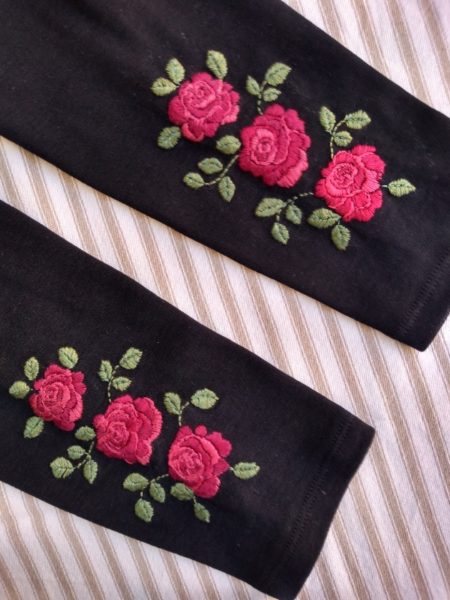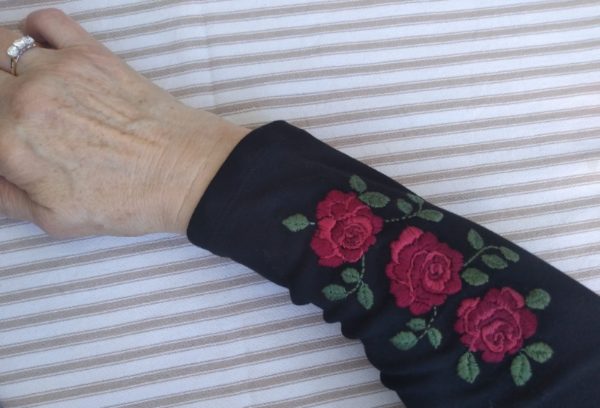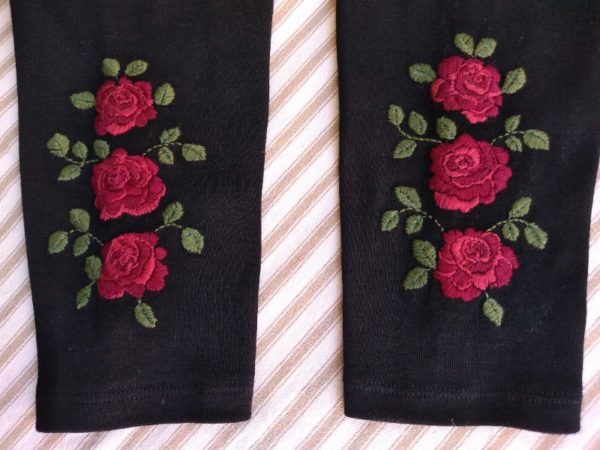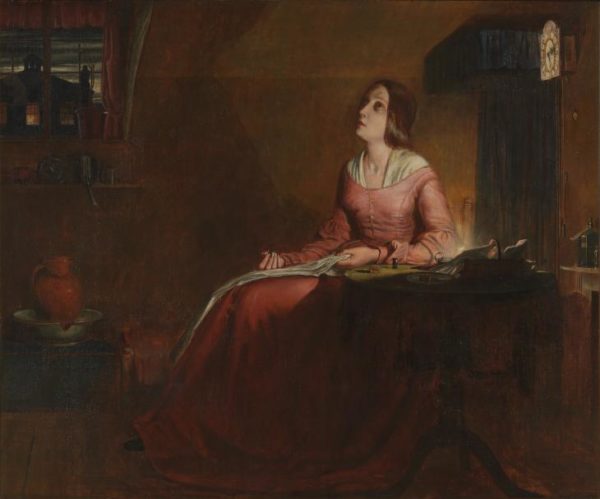
Black T shirt with rose embroidered sleeve (hand embroidered by Mary Addison)
Now I have a bee in my bonnet about embroidering T shirts for myself, there seems to be no stopping me and I have pagefulls of ideas for future sleeves. Embroidery on the sleeves greatly appeals as the effect is peripheral and draws attention to the hands which I find infinitely fascinating the older and more gnarled they get – and as you can see mine are definitely gnarled. Commercially I can see the embroidered sleeve would be a no-hoper as most of the time you never get to see more than half of the sewer’s hard work, but I think that’s partly what appeals to me. (Of course you could stop the design half way round the sleeve, but that seems miserly – an idea which I’m sure is related to our sewing teacher at secondary school who demanded the inside of a garment to be as beautifully finished as the outside. You think you rebel against these ideas, but then a lifetime later you realise you never did!)

Black T shirt with rose embroidered sleeve (hand embroidered by Mary Addison)
Anyway, this week it’s a trio of roses to go up the sleeve, rather than around as I did before. I have an ongoing battle with embroidering roses which I realise comes down to needing to be much less neat and precise with my stitches and not keeping to firm lines for the appearance of petals – another thing to blame on school days, as I now wince to see my grandchildren keeping their colouring within the lines and long to see them pushing colour over those thick black barriers. (I know, I know, it’s done as an exercise in motor control but how often is one of the unintended consequences an inhibition on free flowing drawing and exuberant use of colour?)

Black T shirt with rose embroidered sleeve (hand embroidered by Mary Addison)
This week my husband’s art appreciation talks focused on the way work is depicted. One of the paintings we looked at, The Semptress (1844), by Richard Redgrave shows a young woman in the dim light of a candle wearing what looks like quite a lovely gown (but the light is very dim). Her puffy red eyes are raised in brief respite from her work, her hands are momentarily idle over her sewing; there is just the one candle to work by. It’s the middle of the night and she is obviously working hard to a deadline – through the window houses opposite have lighted windows, suggesting she’s not the only one with a job to be finished. While the painter was not known to be one given to depicting social realism it seems highly likely that he was responding to the poem, the Song of the Shirt, by Thomas Hood in Punch (published anonymously) for the Christmas edition the previous year, 1843. (Click on the link for the full poem.)
With fingers weary and worn,
With eyelids heavy and red,
A woman sat in unwomanly rags,
Plying her needle and thread-
Stitch! stitch! stitch!
In poverty, hunger, and dirt,
And still with a voice of dolorous pitch
She sang the “Song of the Shirt”.

The Sempstress 1846 Richard Redgrave 1804-1888 Presented by John Schaeffer 2014 http://www.tate.org.uk/art/work/T14166
Hood wrote the poem about a real woman, Mrs Biddell, a widow with hungry children, who earned what little money she could sewing shirts and trousers in her own poor garret. Her employer provided the materials but she was made to hand over £2 for them, presumably to ensure she didn’t sell the valuable materials herself. In fact so wretched was her situation that she once she had made the clothes, she pawned them. Indebted to her employer, she was sent to the workhouse. We know no more of what happened to her and her family but the poem highlighted such desperate plights and became important to the cause of those trying to improve the abysmal conditions of England’s working poor.
In the latter half of the C19th magazines like The Graphic became heavily involved in issues of social justice and would themselves commission paintings from eminent artists to flesh out aspects of contemporary life in need of social reformation. Painters for whom The Graphic was patron include Luke Fildes :Houseless and Hungry (1869), Herbert von Herkommer: On Strike (1891) and Helen Allingham, who was also commissioned to do 12 illustrations for Hardy’s ‘Far from the Madding Crowd’ by The Cornhill Magazine. (Vincent van Gogh studied English illustrated journals and it’s fascinating to know her work in particular was said to have influenced him.) Writing for The Graphic at this time were George Eliot, Thomas Hardy and Anthony Trollope.
If I were to sit up half the night to sew it’s because I want to. Rarely do I do that anymore as I find even good artificial lighting a trial. I am picky enough to prefer only daylight and lead a comfortable enough life to be able to do what I prefer. Lucky me. Poor Mrs Biddell.

3 Comments
There’s a comment in more than one Elizabeth Goudge story where she’s describing medieval church carvings of demons and the like “with their tales lashing away in the dark behind them” where no one will ever see them, and only inquisitive fingers will ever become aware of them. I don’t always live up to such ideals, but they are definitely there in my life!
Like misericords which are always good value, especially with children in tow.
Exactly!